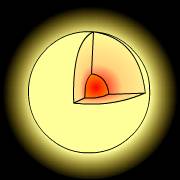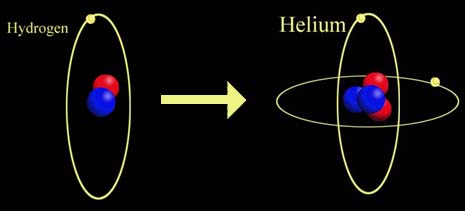Stars
|
Equilibrium: Life Goal of a Star
Look at the diagram on the right. There are essentially two sections of a star: the core (where fusion occurs), and an outer gaseous shell. The core serves as the gravitational “center” of the star. It is very hot and very dense. The outer shell is made of hydrogen and helium gas. This shell helps move heat from the core of the star to the surface of the star where energy in the form of light and heat is released into space. The star’s main goal in life is to achieve stability, or equilibrium. The term equilibrium does not mean that there isn’t any change in the star. It just means that there is not a net overall change in the star. In a stable star, the gas pressure pushing out from the center is equal with the gravity pulling atoms inward to the center – when these forces are equal, the star is at equilibrium. Once a star reaches equilibrium for the first time, it will
start burning (fusing) hydrogen into helium. This 5-step process works like this: Interactive LabSee the Equilibrium Cycle in action! Because interstellar medium is 97% hydrogen and 3% helium, with trace amounts of dust, etc., a star primarily burns hydrogen during its lifetime. A medium-size star will live in the hydrogen phase, called the main sequence phase, for about 50 million years. Once hydrogen fuel is gone, the star has entered “old age.” Let’s see if you understand the relationships between gas pressure, temperature, and gravity as it relates to equilibrium. Consider it a practice quiz so you are ready for the one your teacher will undoubtedly give to you. After Main SequenceWhat happens to a star after the main sequence phase? Old age
and death! How long it takes for a star to die depends upon
its initial mass. A lower-mass star like the sun can survive
for billions of years, but after the hydrogen and helium fuel
is gone it cannot get hot enough to fuse carbon. This type of star dies by puffing off its outer layers to produce
expanding planetary nebulae. These nebulae, which are the remains
of dying stars, serve as the birthplace for future protostars. Let’s look at the relationship between initial mass and length of star life. How long do most stars survive? Millions to billions of years, depending upon the star’s “birth-mass.” Is bigger always better? Not with stars. The more mass a star has at birth, the harder it is to keep that fusion reaction going. It may have more atoms, but the fusion reaction goes faster and therefore burns the star out faster than smaller stars. Bigger is not better in this case! Keep in mind that fusion is what allows a star to maintain equilibrium. If a star cannot achieve a hot enough temperature to initiate fusion, then it’s dying already. Fusion reactions need a fuel, and there are three main fuels that a star uses for fusion: hydrogen, helium, and carbon. HYDROGEN BURNING (Stable Star Life):
Test your knowledge!So what happens when the star is out of hydrogen fuel? Without fuel, there is no burning (nuclear fusion). This fusion is what allows a star to maintain equilibrium.
|





 93%
of interstellar matter is hydrogen gas. 3% of interstellar matter
is helium gas. When a star forms, it has the same composition
since it’s made of the dust and gasses in a nebula. Hydrogen
gas (H2) is split into single hydrogen atoms (H+).
The basic hydrogen fusion reaction is as follows:
93%
of interstellar matter is hydrogen gas. 3% of interstellar matter
is helium gas. When a star forms, it has the same composition
since it’s made of the dust and gasses in a nebula. Hydrogen
gas (H2) is split into single hydrogen atoms (H+).
The basic hydrogen fusion reaction is as follows: